Celebrate Indigenous women
Learn how climate change is impacting Inuit culture, and how they’re adapting to it


When a hurricane hits, where do unhoused people go?

Celebrate Indigenous women
Learn how climate change is impacting Inuit culture, and how they’re adapting to it


When a hurricane hits, where do unhoused people go?



“It’s going to be a loss of culture ... they’ll identify as Inuit and so will their children, but they won’t have the same experiences."
~ Rex Holwell1317 G Street NW, Washington, DC 20005 (202) 347 - 2006 streetsensemedia.org info@streetsensemedia.org
Abel Putu, Abraham Aly, Aida Peery, Amina Washington, Andre Brinson, Andrew Anderson, Angie Whitehurst, Anthony Carney, Anthony Pratt, Archie Thomas, August Mallory, Betty Everett, Beverly Sutton, Bob Davis, Brianna Butler, Brandon Archer, Candice Wilkes, Carlos Carolina, Carlton Johnson, Carol Motley, Charles Armstrong, Charles Woods, Chon Gotti, Chris Cole, Chris Sellman, Conrad Cheek, Corey Sanders, Cortney Signor, Daniel Ball, David Snyder, Debora Brantley, Degnon (Gigi) Dovonou, Don Gardner, Donté Turner, Doris Robinson, Earl Parker, Eric Glover, Eric Thompson-Bey, Erica Downing, Evelyn Nnam, Floyd Carter, Franklin Sterling, Frederic John, Fredrick Jewell, Gerald Anderson, Gracias Garcias, Henry Johnson, Ivory Wilson, Jacqueline “Jackie” Turner, Jacquelyn Portee, James Davis, Jeanette Richardson, Jeff Taylor, Jeffery McNeil, Jeffrey Carter, Jemel Fleming, Jenkins Daltton, Jennifer McLaughlin, Jermale McKnight, Jet Flegette, Jewel Lewis, John Littlejohn, Joshua Faison, Juliene Kengnie, Justin Blakey, Katrina Arninge, Kenneth Middleton, Khadijah Chapman, Kym Parker, L. Morrow, Laticia Brock, Laura Smith, Lawrence Autry, Levester Green, Malcolm Scott Jr, Marcus McCall, Mark Jones, Mango Redbook, Maurice Spears, Melody Byrd, Michael Warner, Michelle Mozee, Michele Rochon, Mildred M. Hall, Morgan Jones, Patricia Donaldson, Patty Smith, Phillip Black, Queenie Featherstone, Reggie Jones, Reginald Black, Reginald C. Denny, Ricardo Meriedy, Rita Sauls, Robert Warren, Rochelle Walker, Ron Dudley, Sasha Williams, Shawon McCrary, Sheila White, Shuhratjon Ahmadjonov, Susan Westmoreland, Susan Wilshusen, Sybil Taylor, Warren Stevens, Wendell Williams
Mary Coller Albert, Blake Androff, Jonquilyn Hill, Greg Jaffe, Stanley Keeve, Clare Krupin, Ashley McMaster, Matt Perra, Michael Phillips, Daniel Webber, Shari Wilson, Corrine Yu
Brian Carome
DIRECTOR OF DEVELOPMENT AND COMMUNICATIONS
Doris Warrell
DIRECTOR OF PROGRAMS
Darick Brown
As self-employed contractors, our vendors follow a code of conduct.

1. I will support Street Sense Media’s mission statement and in so doing will work to support the Street Sense Media community and uphold its values of honesty, respect, support, and opportunity.
2. I will treat all others, including customers, staff, volunteers, and fellow vendors, respectfully at all times. I will refrain from threatening others, pressuring customers into making donations, or engaging in behavior that condones racism, sexism, classism, or other prejudices.
3. I understand that I am not an employee of Street Sense Media but an independent contractor.
4. While distributing the Street Sense newspaper, I will not ask for more than $2 per issue or solicit donations by any other means.
5. I will only purchase the newspaper from Street Sense Media staff and volunteers and will not distribute newspapers to other vendors.
6. “I will not distribute copies of “Street Sense” on metro trains and buses or on private property.”
7. I will abide by the Street Sense Media Vendor Territory Policy at all times and will resolve any related disputes with other vendors in a professional manner.
8. I will not sell additional goods or products while distributing “Street Sense.”

9. I will not distribute “Street Sense” under the influence of drugs or alcohol.
10. I understand that my badge and vest are property of Street Sense Media and will not deface them. I will present my badge when purchasing “Street Sense” and will always display my badge when distributing “Street Sense.”
DIRECTOR OF VENDOR EMPLOYMENT
Thomas Ratliff
VENDOR PROGRAM ASSOCIATES
Aida Peery, Clifford Samuels
VENDOR PROGRAM VOLUNTEERS
Roberta Haber, Ann Herzog, Madeleine McCollough, Dylan Onderdonksnow
MANAGER OF ARTISTIC WORKSHOPS
Maria Lares
EDITOR-IN-CHIEF
Will Schick
DEPUTY EDITOR
Kaela Roeder
PRODUCTION EDITOR
Athiyah Azeem
STAFF REPORTER
Annemarie Cuccia
EDITORIAL INTERN
Neil Franklin
MICHAEL STOOPS DIVERSITY FELLOW
Rex Holwell,
poses for a photograph near a SmartBUOY.
Originally founded as a street newspaper in 2003, Street Sense Media has evolved into a multimedia center using a range of creative platforms to spotlight solutions to homelessness and empower people in need. The men and women who work with us do much more than sell this paper: They use film, photography, theatre, illustration, and more to share their stories with our community.
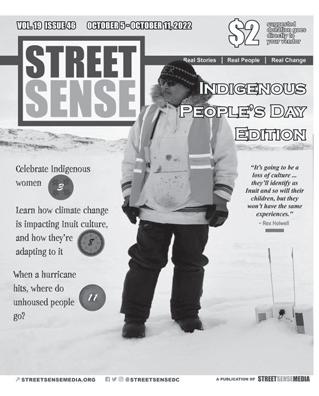
Our media channels elevate voices, our newspaper vendor and digital marketing programs provide economic independence. And our in-house case-management services move people forward along the path toward permanent supportive housing.
At Street Sense Media, we define ourselves through our work, talents, and character, not through our housing situation.
Sophia Thomas
ARTISTS-IN-RESIDENCE
Ariane Mohseni (Film), Bonnie Naradzay (Poetry), David Serota (Illustration), Lalita Clozel (Film), Willie Schatz (Writing)
ARTS EDITOR (VOLUNTEER)
Austine Model
OPINION EDITORS (VOLUNTEER)
Rebecca Koenig, Emily Kopp, Lydia DePillis, Bill Meincke, Candace Montague
EDITORIAL VOLUNTEERS
Josh Axelrod, Ryan Bacic, Katie Bemb, Lilah Burke, Chelsea Ciruzzo, Lenika Cruz, Alison Henry, Kathryn Owens, Nick Shedd, Andrew Siddons, Jenny-lin Smith, Rebecca Stekol
While people around the world increasingly experience the alarming effects of climate change, solutions to healing the planet have been right in front of us all along.
Countless Indigenous peoples have lived in reciprocity with Earth since time immemorial. Despite centuries of colonization and ongoing threats to their sovereignty, Indigenous peoples collectively sustain 80% of the world’s remaining biodiversity today, including ecosystems essential to our global climate, fresh water and food security. Indigenous practices offer a critical pathway to healing a planet in crisis, and a unique global art project is recognizing inspiring Indigenous women leaders upholding both Indigenous rights and guardianship of collective territories.
“Thriving Peoples. Thriving Places.” is the latest in a series of collaborations between Nia Tero, a global non-profit working in solidarity with Indigenous peoples to strengthen guardianship of Earth and all beings, and Amplifier, a nonprofit design lab that makes art and media experiments to amplify the most important social movements of our time.
Expanding upon the 12 portraits commissioned in 2021, this year’s four new portraits are a collaboration between illustrators Tracie Ching (Kanaka Maoli) and Cindy Chischilly (Diné). The art will be available digitally and at public art events in cities including Seattle (USA), Auckland (Aotearoa) and Manila (Philippines). The project celebrates the vibrant and ever-present leadership of Indigenous women in protecting biodiversity and leading grassroots movements to drive action for the health of the planet.
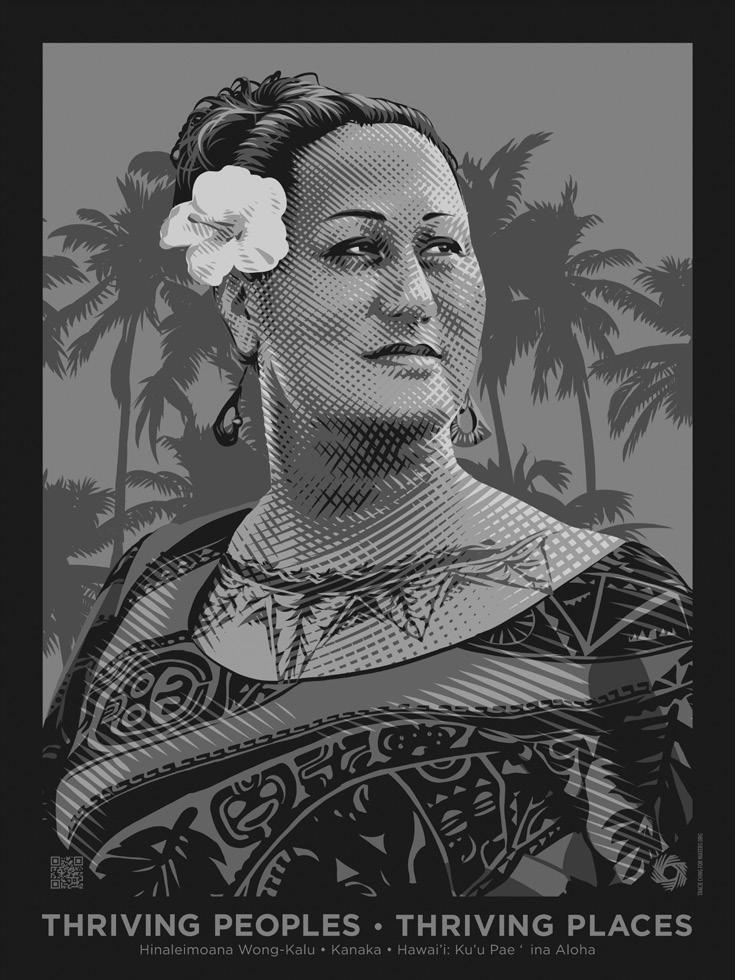
This year’s activation launches on Oct. 10, Indigenous Peoples’ Day. Like International Day of the World’s Indigenous Peoples in August, activities on this day recognize the harm of colonialism and the importance of Indigenous land sovereignty.
The Indigenous women being honored with portraits this year are activists, educators and climate experts working not for personal gain but for collective thriving, rooted in their ancestral homelands across Turtle Island, Africa, and the Global South. Each carries forward traditional knowledge honoring their ancestors while shining a path for future generations.
As we head toward the 2022 United Nations Climate Change Conference of the Parties (COP27) in Sharm El-Sheikh, Egypt and United Nations Biodiversity Conference (COP15) in Montreal, Canada, it is crucial to remember that climate solution conversations don’t just happen during state-led meetings. The women honored in this initiative and many more like them are driving change daily and weekly, locally and regionally, and across cohesive networks of Earth guardians. The organic and ceaseless ways in which Indigenous knowledge is conveyed are not unlike the street paper network bringing this story to you today: purposeful, vigilant, community-led, and future-focused.
This year’s “Thriving Peoples. Thriving Places.” campaign continues to elevate the importance of women in movements toward Indigenous sovereignty and participation in climate solutions. Despite facing gender-based violence, educational barriers, and economic hardships, Indigenous women unfailingly show up, inspiring action and creating change.
The Indigenous leaders recognized here are reticent to put themselves in the spotlight. Instead, they work tirelessly and in reciprocity with the planet and the communities around them. Their work never stops – and nor should our support of them. This Indigenous Peoples’ Day – and every day – is a good time to ask: “How can I support what these dedicated women are doing? And how can I create a brighter future for my community and Mother Earth alongside them?”
To learn more about this year’s ‘Thriving Peoples. Thriving Places.’ campaign and see the portraits, go to: NiaTero.org/ThrivingPeoples
• Street Sense will be closed Monday, Oct. 10, for Indigenous Peoples Day.
• Apply for a job at Street Sense! Must submit a resume by Friday, Oct. 14. See in-office announcement for details.
• New workshops and workshop times!
• Watercolor workshop is every Tuesday at 11:45 a.m
• Women’s workshop is every Tuesday at 2 p.m.
• Theater workshop is every Wednesday at 11:45 a.m. on the 3rd floor.
• Photography workshop is every Thursday at 11:45 a.m.
This article is part of a limited series exploring the history, current policies, and initiatives to create equitable transit-oriented development in the region.
over the past 30 years, rental apartments and condos conveniently located near transit hubs, shops, jobs and leisure activities — also known as transitoriented development — have proliferated in D.C. and throughout the region. The environmental and human health benefits of TOD are well documented, but many longtime residents in D.C. feel this housing is built for the city’s growing class of new, wealthier inhabitants, say local housing advocates and experts.
As development mushroomed mostly west of the Anacostia River in recent decades, low-income and Black residents were priced out of these economic hot spots at some of the highest rates in the country. An Institute on Metropolitan Opportunity survey shows the most intense demographic and economic change from 2000-2016 occurred in Ward 6 and parts of downtown. While much of D.C.’s new development prioritized transit access, to the east there’s little TOD to be found.

“I feel like, unfortunately, those types of units are not affordable for a lot of the residents who were born and raised in the city,” said Rufaro Jenkins, former president of the Tenant Association for Parkway Overlook, a Congress Heights apartment complex with affordable units. Tenants there fought for a decade to get the building redeveloped in a way that would allow them to stay.
By the time the D.C. government made a deal in 2018 to preserve Parkway’s 220 affordable rental units, Jenkins had already purchased a house in the area. The renovated housing was nonetheless a victory for former tenants who were able to move back in, including two of Jenkins’ adult children.
Although Parkway serves a pressing need, the property only contains residential units and isn’t close to a Metro station. As such, it lacks the conditions that Priya Jayachandran, CEO of the National Housing Trust (NHT), said make a community come to life.
“When you have transportation nodes like a Metro stop bringing that full panoply of resources that people need in their lives — jobs, healthy foods, transportation and potentially entertainment — all within walking distance, (you have) the hallmarks of healthy, vibrant communities,”
said Jayachandran, who has worked for the past six years with another group of Congress Heights residents to bring a TOD project to the corner of Alabama Avenue and 13th Street SE.
Besides Park 7 — a massive mixed-use property near the Minnesota Avenue Metro station with 377 mostly affordable rental units, retail, and lots of controversy — the half-dozen people interviewed for this article were hard-pressed to think of existing transit-oriented development in wards 7 and 8. That’s about to change.
Building footprints and number of housing units in each census tract.
Nearly a decade after Park 7 was completed, plans for TOD projects east of the Anacostia River are gaining steam. Fed up with rodents, mold, and unsafe living conditions, the mostly elderly tenants of a rent-controlled apartment complex next to the Congress Heights Metro station fought to redevelop their homes while keeping them affordable, and
‘Transit Oriented Development’ is finally coming east of the Anacostia River. Why did it take so long?
in January 2022 they won their suit. Besides housing, the Congress Heights Metro station project also includes new shops and offices.
Standard Real Estate Investments acquired the twoacre site and its seven properties. The firm is partnering with developer Trammell Crow Company and NHT Communities, the nonprofit development arm of NHT, to build 179 residential units catered to households earning between 30% and 80% of the area median income.
The Congress Heights Metro station project is part of WMATA’s recently released 10-year strategic plan for TOD projects throughout the region. Guided by this document, the D.C. government aims to build a portfolio of new transitoriented developments.
There are two other housing projects planned steps from the Congress Heights station, under the D.C. Office of the Deputy Mayor for Planning and Economic Development (DMPED): the multiphase St. Elizabeths East redevelopment on a 183-acre lot, which will eventually contain housing, shops, educational and community space, and the Malcolm X redevelopment, which aims to transform a 45,000 squarefoot parcel of land on a former elementary school campus into housing for educators, among others.
The Bridge, a project from MRP Realty in collaboration with the Bethlehem Baptist Church, will be a 3-minute walk to the Anacostia Metro station and include 11,000 square feet of retail, 118 mixed-income units, and a community center. The apartments will be for households earning up to 50% of AMI, except six permanent supportive housing (PSH) units for households earning up to 30% of AMI, according to reporting from Urban Turf. Gragg Cardona Partners, Foundation Housing, and Carding Group are planning to build the Residences at Benning Road, near the eponymous Metro Station, with commercial spaces as well as affordable assisted living units.
As a handful of TOD projects crop up across the Anacostia River, there are still barriers to creating the kind of growth that has proliferated west of the Anacostia in neighborhoods like Columbia Heights, NoMa, and Navy Yard for years–and ensuring those benefits are equitably distributed. Creating TOD projects with all of their defined components — in walking distance of a transit station and the inclusive of both residential and commercial spaces — can be challenging.
“When you are adjacent to transit, you’ve got shared systems, shared ownership, agreements to navigate with the District and the federal government, (and) cost overruns [when] having to redesign,” Jayachandran explains. “The development is just a lot more complicated.”
Building TOD east of the Anacostia — in communities that have experienced decades of disinvestment from government agencies and private entities, often rooted in racial biases and systematic discrimination — comes with additional unique barriers.
For WMATA, which has the potential to build 26,000 new housing units through TOD projects planned throughout the region, the issue is inventory. According to Steven Segerlin, the director of real estate development at Metro, the agency does not own much land in the District and its only east of the river stations with enough land to develop are Congress Heights, Anacostia, and Deanwood.

Therefore, of 11 projects under contract in Metro’s new strategic plan, only one of them — the Congress Heights mixed-use development — is located east of the Anacostia. And while the projects near Anacostia and Deanwood stations are referenced in the plan, they are classified in groups of developments that could either take at least 10 years to be under contract, have site constraints, or require additional coordination.
Another issue when it comes to developing mixed-use properties that are affordable to low- and moderate-income households can be financing. According to a DMPED
spokesperson, lenders may require a high percentage of signed lease agreements before funding, and there are additional challenges.
“Unlike other parts of the city, mixed-use TOD developments east of the Anacostia River often need more subsidy for both the residential and the retail components since market-rate residential rents typically aren’t high enough to support market-rate/mixed-income residential development,” said a DMPED spokesperson via email.
Beyond Housing Production Trust Fund resources, D.C. agencies are tackling the issue by providing gap financing for projects that attract private investment to underserved communities, prioritizing projects close to transit and other amenities, and “leveraging the District leasing power,” according to DMPED.
In some cases, barriers to TOD are more literal. Last year DDOT opened a pedestrian bridge for residents of the Parkside development to reach the Minnesota Avenue station. While developers label Parkside as TOD, it’s worth noting that to access the Metro stop, members of the growing community around Parkside must cross over the Anacostia Freeway, which continues to divide the area and kick off noise and pollution.
“If you can fly, it could be great. But (in reality), connectivity and the ability for people, regardless of their mode of transportation, to have direct access and efficient access to that location is critical. It’s fundamental to how we understand what it means for something to be genuinely accessible,” said Melissa Bondi, the state and local policy director at Enterprise Community Partners’ Mid-Atlantic office.
Challenges to building meaningful TOD can be diverse. Sometimes, the harm comes from planning projects without considering residents’ needs. Bondi has seen cases in which “a highway is bifurcating half of a neighborhood from accessing that grocery store and they can’t get to it… as if anybody should have a monopoly on people’s access to food.”
Since food is a basic human need, some argue that building around food access can yield similar benefits to TOD, or work in tandem with that framework. While it seems like a no-brainer to build grocery stores in food deserts and near housing, Bondi has seen major grocery chains block competing stores from opening within a certain radius of their facility — consider Safeway’s efforts to monopolize the Ward 7 grocery market.
In other cases, it can be difficult to convince developers and property managers to build something residents want, when they “could be nervous about how much money they could get,” said Bondi. Typically, investors plan for the amenities they think will generate the most profit.
“Is (a grocery store) the highest and best return on their investment compared to other commercial (options) they could put in that same space?” Bondi said. “So we have this conflict over what are we maximizing — the profit on the building or the value and benefit of the building? Because a really well patronized, small grocer could be a huge asset for everyone, including the building.”
As more TOD projects advance in communities east of the Anacostia, residents will likely be forced to advocate for the designs and amenities that best serve their needs. Still, Bondi remains optimistic. “We work really hard to persuade (developers) that it’s worth their perceived risk.”
AD.C. Council committee on Monday advanced a bill that would give most D.C. residents up to $100 a month to be used for Metrorail and Metrobus, effectively making public transit free — or at least significantly cheaper — for many city-based users.
The council’s five-person transportation committee unanimously voted to approve the bill, sending it to the full legislature for debate and a first vote as early as October.
During a brief discussion on Monday afternoon, lawmakers touted the measure as a means to boost ridership and offer the transit agency a steady source of additional revenue from D.C., especially as it navigates financial difficulties caused by the pandemic.
“I think that this is a major step forward. First, we need to help our transit system. It’s in a lot of trouble, and this will do that. The second thing is, it will increase ridership and increase transit use with all the benefits that accrue,” said Councilmember Mary Cheh (D-Ward 3), the committee chairperson. “It’s not cheap, but the repayment to us as a community will be worth it.”

The bill, first introduced by Councilmember Charles Allen (D-Ward 6) in 2020, would provide a monthly $100 subsidy to D.C. residents to be used on Metro, building on the existing Kids Ride Free program, which serves more than 50,000 D.C. school children on an annual basis. (The D.C. Streetcar is also free, and Mayor Muriel Bowser tried unsuccessfully in the past to make the D.C. Circulator free.)
While free public transit has been adopted more broadly
in parts of Europe, U.S. cities from Olympia, Washington to Kansas City, Missouri have in recent years tested the idea. In Montgomery County, Ride On buses were free until July 2022 as part of a two-year program, and earlier this year Boston eliminated fares on three bus lines for two years.
Under the bill, qualifying residents would get the initial $100 subsidy, and get monthly installments thereafter to keep them at that level. (So if a rider only spent $25 on Metro in a given month, they would get $25 as a subsidy the following month to bring them back to $100.) Any expenses above the monthly subsidy would have to be covered by the user. According to the committee, the $100 a month would cover the transit needs of 92% of adult users in the city.
The legislation would also create a Transit Equity Fund that would dedicate $10 million a year for the D.C. Department of
Transportation to “improve transit infrastructure and service in areas of high transit need or historically underserved communities,” according to a committee report, thus ensuring reliable service.
In comments during the hearing, Allen said the subsidy would help Metro and its users.
“As we are faced with the economic recovery, it’s absolutely imperative (to get people back on Metro). Metro’s success is so closely linked to the District’s success and frankly, the region’s success. It’s how our residents get to and from work. It’s how neighbors move around their community. It’s how students get to and from school. It’s what small businesses rely on to get customers to and from their storefronts, as well as their employees,” he said.
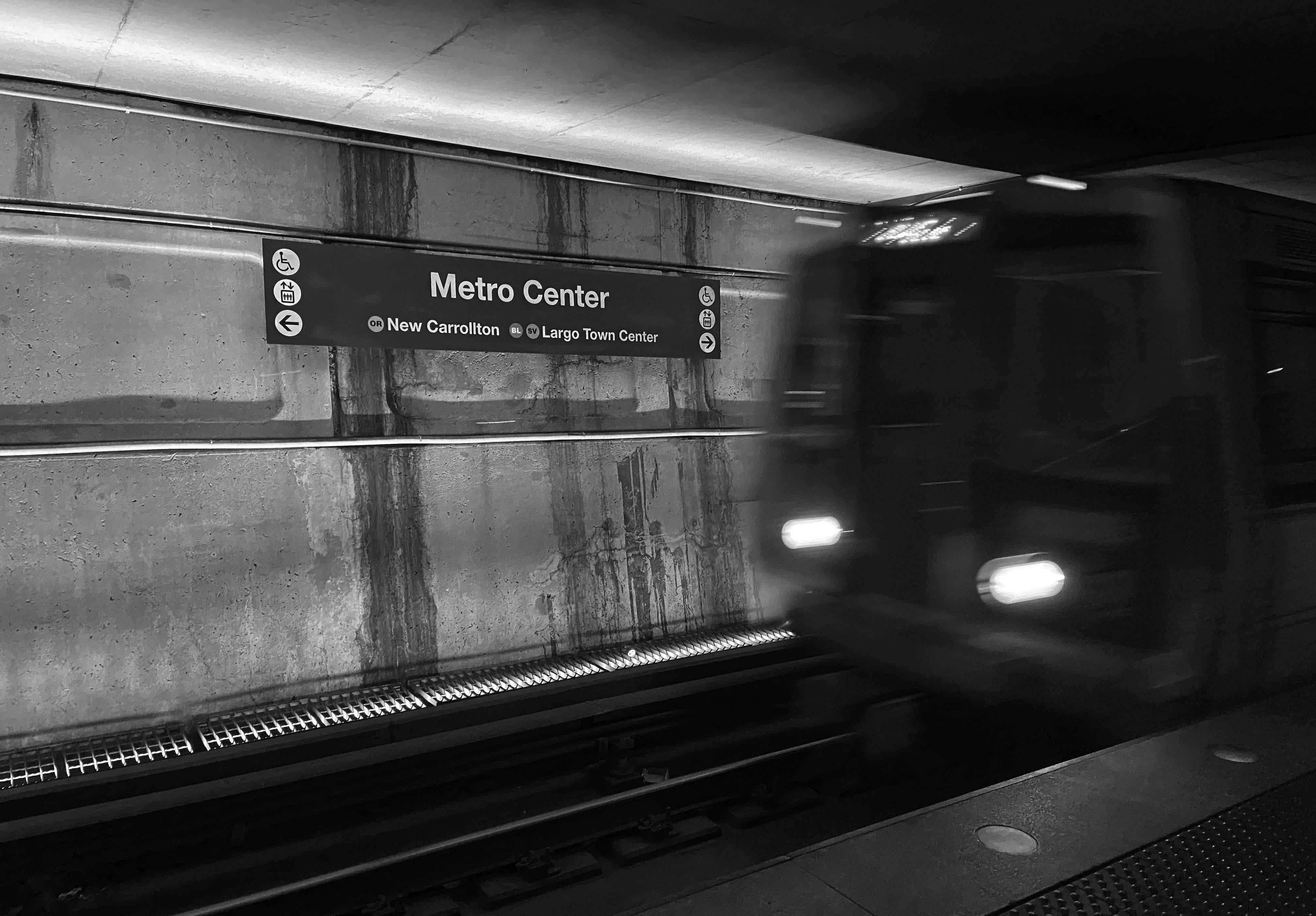
Initial plans to offer the subsidy only to lower-income residents were scrapped because of what the committee said would be a costly and “significant administrative burden” to verify incomes. Additionally, it said, “making the subsidy immediately accessible to all income levels would still disproportionately benefit lower income residents, who are less likely to have access to workplace subsidies and spend a higher portion of their incomes on transportation.”
According to a study on the legislation by the council’s budget office, 78% of D.C. residents do not currently receive
any transit subsidies from their employer. Additionally, white residents are more than twice as likely to get a workplace subsidy, and higher-income riders were five times more likely to receive a subsidy than lower-income users.
The legislation would exclude federal employees who receive transit subsidies, mostly because those subsidies are currently worth more than $100 a month and the committee said beneficiaries would be unlikely to opt out of them.
The biggest question mark around the bill is the price tag, which the city’s chief financial officer pegged at $373 million for the first four years. While the legislation says the costs will be covered by the additional (and unexpected) revenue that D.C. has been taking on a yearly basis, the committee report also concedes it is “by no means a predictable funding source” and could decrease significantly or disappear altogether if the economy sours.
Still, the committee says the proposed funding is “a creative solution that would potentially allow scaling up this large program rapidly without having to raise taxes or fees.”
“As our budget grows, we’re going to be giving it back to our residents,” said Allen. “We’re going to help them pay to get to and from work, to get to the doctor’s office, to get those groceries or to visit family in the region. I’m really excited about what this program is going to mean for district residents
who struggle to pay for all their needs and who rely on public transportation.”
Councilmember Christina Henderson (I-At Large) stressed that while the subsidy could help boost ridership, the region would have to keep pushing to ensure that Metro service is reliable. She also said Maryland and Virginia would have to start considering their own options to help bring people back to transit.
“We need to figure out how do we get people to get back on public transportation in the numbers that at least we saw pre-pandemic. For some folks, it’s cost as a barrier, but for a lot of people is around the reliability piece,” she said. “As we modernize the system and look forward, I think this is one tool in our toolbox to help sort of boost ridership and to add some additional funding. But if any other jurisdictions are listening, it is going to require that all of us, especially Maryland, Virginia, are doing their part as well.”
This article was originally published by DCist
 MELISSA RENWICK Reuters / International Network of Street Papers
MELISSA RENWICK Reuters / International Network of Street Papers
Rex Holwell has spent his life on the sea ice that forms each winter off the coast of Newfoundland and Labrador in eastern Canada. Like other Inuit, he learned to hunt seals and fish from his father and other men. They would skim over the sea ice, first on dog sleds and then, by the time Holwell started accompanying them, on gasoline-powered skidoos. Holwell wants this life — and freedom — for his children.
Climate change is about to upend it all.
“It’s going to be a loss of culture,” says Holwell. “They’ll identify as Inuit and so will their children, but they won’t have the same experiences."
As droughts last longer and heat waves, flooding and storms intensify in an ever-warmer world, the Inuit are doing what they have always done: adapt.
For the past three years, Holwell, 47, has helped run a sea ice monitoring program for the Inuit. Unlike other climate data efforts, this one is completely focused on the needs of the local community. The program is called SmartICE and pairs traditional Inuit knowledge with data collection buoys and electromagnetic sensors to give northern communities real-time measurements of sea ice thickness along their ice "highways" through a website, downloadable phone app or Facebook. It highlights areas with thicker ice and those with thinner ice.
SmartICE is used by more than 30 Inuit communities. The idea is to use the technology to fill in where climate change has made traditional knowledge less reliable or created conditions the Inuit haven't faced before.
Holwell believes tools like SmartICE can extend the time the Inuit have left on the sea ice before it disappears. A new analysis published in Nature Communications Earth and Environment in August showed that the Arctic warmed nearly four times as fast as the global average between 1979 and 2021 – far faster than the two or three times the global average usually cited.
Separate modelling by experts in the United Kingdom, Canada and the United States shows that as soon as 2035, Arctic sea ice might drop below 1 million square kilometers during the summer. Scientists recorded this year's sea ice minimum on Sept. 18, which was tied for the tenth lowest on record.
The Inuit are practical when it comes to new technology. They use GPS but still teach their children how the prevailing winds cause the snowbanks to lean and point the way home if the device’s batteries die. Skidoos, also known as snowmobiles, have mostly replaced dog sleds and have compressed weeklong hunts into day trips. Rifles have replaced harpoons.
SmartICE is another tool. And so, with a black-and-red skidoo, a rifle, and an electromagnetic sensor, Holwell offers a vision of survival that joins the old and the new.
"We have to adapt to climate change," he says. "We're going to need more tools like SmartICE."
If the weather is good, a 19-passenger Twin Otter plane flies to Holwell's hometown of Nain. No carry-ons are allowed. If a bag weighs more than 50 pounds, it might be left behind for the next flight, or the flight after that if the planes are overweight.
There is no de-icer in Nain — or in any of the coastal Inuit communities in Labrador — so the planes are often grounded. An elderly couple who was stuck in Goose Bay in mid-April say the longest they’ve waited for a flight was three weeks. The delays are especially bad in the spring, when the fog can be thick and unpredictable, they say.
In Nain, cars and trucks sit in front yards mounded with snow, while skidoos zoom along the slushy streets picking children up from school and bringing adults to work. There is only one hotel in town — the Atsanik Hotel — which is also the only restaurant in town. Toilet paper, which comes in bundles of 30 rolls, costs $29.
More than Nain itself, it's the landscape around it that is home, says Jim Anderson.
"That’s one thing people don’t understand," says Anderson, 70. "We get culture shock as soon as we go out. We get lost. (We're) not used to when you can see all the houses — houses end-on-end with no open spaces."
For $60 (Canadian) in gas, a hunter can kill a seal and feed a family for three or four days, plus make mittens, boots and other clothing out of the animal's skin. Shipping in an
equivalent amount of store-bought food costs $300 (Canadian) and clothing isn't included. The sea ice makes life more affordable.
The sea ice also means freedom. Most people can't afford a boat so in the summer their world literally shrinks and becomes hostile with bugs. But in winter and spring, when the sea ice is frozen, people can fish, hunt, get wood and visit their cabins.
Maria Merkuratsuk, who was raised in a cabin north of Nain, says she feels "tingly" when she is out on the ice. "I feel at peace, I can breathe … if I have a lot on my mind, my body can take over … I (can) just drive and drive and drive and think about things," she says.
Isaac Kohlmeister, one of the last two people in Nain to run a dog sled team, says being out on the ice has helped ground him.
"When the dogs are running, you can feel everything," he said. "You can feel the fish under the ice, even."
The Inuit communities Holwell is working with for SmartICE have started compiling their own lists of Inuktitut words for different types of sea ice. In Nain, they've come up with 37, which they plan to publish in a booklet next year.
There are two parts to the SmartICE program. The first are 9-foot tall "SmartBUOYs" deployed in holes drilled through the sea ice at the beginning of the season and removed at the end of the season. The buoys are filled with thermistors, which can be used to measure temperature, and record data at specific locations. The sea ice thickness is calculated from the difference in temperature between the atmosphere, snow, ice and saltwater.
The second part of the program are "SmartKAMUTIK" sleds pulled behind skidoos. The sled carries a plywood box with an electromagnetic sensor. As the skidoo pulls the sled, the sensor sends out electromagnetic pulses to induce a current and measure the thickness of the snow and ice. Holwell typically makes a SmartKAMUTIK run once a week to check the thickness of Nain's sea ice "highways."
The technology the Inuit are using is the same as what some climate scientists use, but the questions are different. The scientists are mostly asking system-level questions, like what happens next for the planet; the Inuit have more immediate concerns, like whether they will fall through the ice if they go hunting or to visit friends and relatives. The Inuit need more granular data, and sampling locations that might be different from where scientists would choose. But increasingly it's projects that address both scales of concern that are finding support.

Katie Winters, 54, who lives in Nain and helped translate the Inuit land claim agreement in Labrador, says even though the sea ice is thicker this year, it has been one of the worst years for people falling through the ice. She immediately names five people and two skidoos that have fallen through the ice this year but says there are more. Luckily no one died.
A community management committee tells Holwell where the SmartBUOYs should go, and as the temperatures warm in the spring, he uses the SmartKAMUTIK to carefully check locations that are known to be dangerous.
Holwell trains anyone who is interested how to make the SmartKAMUTIK runs and teaches teenagers how to build SmartBUOYs during the summer off-season. The team posts every run on the program's SIKU website and app, and on Facebook. It's not clear how much people in the community rely on the data but they "like" and comment on the posts.
For people without an internet connection, Holwell prints off maps with ice thickness measurements, and, because everyone hunts, marks the maps with symbols where animals were spotted or harvested.
SmartICE got $293,000 in seed funding from the Arctic Inspiration Prize, the biggest annual prize in Canada. It's won other prizes too, and has slowly been gaining international recognition.
Holwell's pride in the project is obvious. "We’re a production facility in Inuit lands, with Inuit people building the technology
Ask anyone in Nain about the sea ice and they say they're seeing the effects of climate change first hand. The sea ice used to be 5-7 feet thick, hard, and covered with a thick layer of snow. Now it's 3-4 feet thick and soft, says Ron Webb, 65.
The snow is sugary with a glittery coating — "crappy snow," Webb calls it. The huge blue chunks of multi-year ice that used to float down from the north are gone and summer tides are stronger, he says.
Last year, Webb was driving his skidoo on 3 feet of sea ice. It felt good but he shoved a stick into it just to check and the stick went through to open water.
“Years ago, you wouldn’t have that. That’s kind of scary because even though the thickness is there, the hardness is not," he says.
Webb laughs. The Inuit in Nain call themselves "Sikumiut" or “people of the sea ice” but he has started joking that they should make another adaptation — switch to using hovercraft — to navigate sea ice too dangerous for a skidoo.
Spring is the best time to be out on the sea ice. The days are longer but nights are still cold enough to freeze. In April, for example, temperatures usually drop to 5 to 14 degrees Fahrenheit overnight – but this year temperatures hovered
around zero.
"Usually, it’s like a heart monitoring machine – up and down – but it’s been flatline warm the whole month of April,” says Joey Angnatok, a former program coordinator for SmartICE.
Communities living on freshwater lakes and rivers in northern Canada have begun asking about SmartICE. Holwell says Sami caribou herders and others in Sweden, Finland, Iceland and England have also asked about the technology.

“We’re needed, Team Canada, we’re needed,” says Holwell. Then, like a small town auctioneer or a politician on a stump speech, he delivers his pitch: “We want Joe in Tuktoyaktuk to be a SmartICE champion.”
A little later he heads out on his skidoo, flying across the sea ice like a giant tundra bumblebee in the brief sub-Arctic spring — joyful, free, with no question of his place in the world.
Opening the throttle, he speeds toward the horizon where the geese and seals are, deeply certain that his tiny Inuit town on the edge of the sea ice matters, and that now the rest of the world knows it too.
Courtesy of Reuters / International Network of Street Papers
for other Inuit," he says.Holwell rides a skidoo during a weekly SmartKAMUTIK run towards Nain Bay, a popular fishing spot for community members in Nain, Newfoundland and Labrador, Canada, April 21, 2022. The SmartKAMUTIK uses electromagnetic sensors to measure the sea ice thickness and give northern communities real-time measurements of sea thickness along their ice "highways" through a website, downloadable phone app or Facebook. Photo by Melissa Renwick // Reuters Darcel Noah, 13, catches a fish during an outing organized by the local youth center, outside of Nain, Newfoundland and Labrador, Canada, April 19, 2022. "I learn how to cut fish and cook it, and how to catch birds," she says. Photo by Melissa Renwick // Reuters
 WENDELL WILLIAMS
WENDELL WILLIAMS
On my quest to see as much of the world as I can with the time I have left on this planet, I have mastered the skills of three-day trip planning. One of the places a travel partner and I picked out recently was the low country of Georgia and South Carolina, partly because of its rich culture directly linked to the history of slavery. When we purchased the flights long ago, we were not even aware of what time of year it was for that part of the country.
On the day of our departure, we rushed to the airport running late as usual, without checking the weather forecast for our destination. It never occurred to us that it was hurricane season when we touched down at our base in Savannah. We'd almost have to pay dearly for that lapse a few days later. See what happens when you're rushing.
We drove up the coast of South Carolina to Hilton Head Island, and then to an old friend's family home near Myrtle Beach. We weren’t even listening for weather warnings, just a beach music station. We saw all the vacationing people like ourselves enjoying the sunny weather.
And all along as I do when going anywhere, I was on the lookout for people experiencing homelessness, and found many even in areas that were supposed to be "upscale." I noticed them in the resort towns as well as in Savannah, in the places I'd normally look. Even in this sleepy southern city, they were there, especially in the shopping districts favored by the tourists. Yes, they were, if you have the eyes to see them. The weather was great, so I thought if I had to experience homelessness, this place with a year-round mild climate would do. But the one thing that I forgot about was that this area is in the path of hurricanes from time to time. And when we woke up the next morning, I could see something was different in the sky.
There was an eerie feeling all around as the dollar store near my hotel boarded up its windows. Did I miss a notice about a Black Lives Matter rally or something? We turned on NPR and really got woke up with the news that this area might be in the path of Ian. When others asked me if I’d heard about it, I thought that they were talking about some guy. The storm was predicted to reach land as a category 3 or 4, possibly as a direct hit. All of a sudden, special news flashes came over both our cell phones and interrupted all radio programming with warnings.
That’s when I said to myself: "What about the homeless?" Almost everything I listened to had given detailed instructions on what to do, but I heard absolutely nothing about those who were unhoused. What would be their lot? If you're homeless, evacuate where, and how?
On our last full day there, the sky told the story of what was to come. I've heard about how the animals know first and I noticed flocks of birds flying off in formation. Had I been paying attention, I'd have noticed they were headed away from the impending danger. But all around town that afternoon, I didn't sense panic. Maybe because the residents are so used to these emergency situations. I was not.
We decided to soldier on, but the sky got darker as we left our late lunch where only one other couple was dining. As we drove around, the crowds of shoppers and tourists got thinner as people headed in to prepare. Yet still, I saw no efforts on the streets aimed at taking the unhoused to safety. As I started towards the museums, I looked for my
brothers and sisters and saw some police officers talking to individuals as I ran into a souvenir shop trying to address my obsession with travel magnets. At 3 p.m., the pedestrian mall had none of the previous day's tourists and unhoused people.
We started to panic a little, thinking about what we had seen of New Orleans last year, where you could still see the damage from Katrina and homeless encampments everywhere. I'd heard that special shelters had been set up for peoples’ pets, and a call for volunteers to round up pets and rescue animal lovers who couldn't bear leaving without them. I remember news reports of flamingos being put in bathrooms for safety. But mysteriously, I heard absolutely nothing about any efforts to pluck the unhoused off the streets ahead of the storm.
After a mad rush to make a 6 a.m. full flight the next morning, in an hour or so we were back to BWI and grateful to be out of harm's way. But very quickly I was hit with a bout of survivor's guilt for having a place to go home to. Driving in, it was hard not to think about the faces I saw on the streets of Savannah and the surrounding areas. What will happen to them? Having been homeless in Michigan in the winter, I understood what it was like to be stuck outside in the elements. Which is worse, being outside in several feet of snow or trying to stay alive in waist-high water?
So, I started to make calls to contacts at national homeless organizations, and got a few different responses to my questions about policy for the safety of those unhoused on the street during a weather emergency. The partial answers I got were disturbing.
It seems there are local, state and national policies concerning shelters during a major weather event, but they didn’t make much sense. I heard of getting people out prior to the storm hitting, but nothing on the news about where the homeless should go. I even heard the mayor of Charleston encouraging its citizens to go home, stay put, and batten down the hatches. But how would that work for the residents with no homes and no hatches? Should they do what a 62-year-old homeless Florida man did, according to The Washington Post — seek shelter under a Burger King’s awning in a folding chair? This man had already suffered three heart attacks. I guess he was one of the lucky ones.
It’s sad that franchises may be the only option for some when most community members were being searched for and rounded up by an army of volunteers who even used apps to count and find some unaccounted-for citizens. How's that supposed to work out for poor and unhoused people, many of whom don’t have an operating smartphone?
In a few of those telephone inquiries, sources suggested that homeless people would be eligible for Federal Emergency Management Agency shelters. But the president of the United States has to declare a national emergency before FEMA comes in. That's right, no shelters before the storms -- only after. So, somehow if you're unhoused you first have to survive the event to get emergency shelter.
Sounds backwards, doesn't it?
What I've learned from all of this is each and every one of us who truly cares about the everyday plight of the homeless now need to add to their list of concerns: What is the local plan for our fellow men and women who may be caught in weather we'd never consider going out in?
Wendell Williams is an artist and vendor with Street Sense Media. REGINALD DENNY Artist/Vendor
REGINALD DENNY Artist/Vendor
It is my sincerest prayer that those who have an ear to hear will ingest these words that are penned here. Pastor Wintley Phipps says: “It is in the quiet crucible of your personal private suffering that your nobelest dreams are born and God’s greatest gifts are given in compensation for what you’ve been through. Watch your thoughts, they become words; watch your words, they become actions, watch your actions, they become habits; watch your habits, they become character, for it becomes your destiny.”
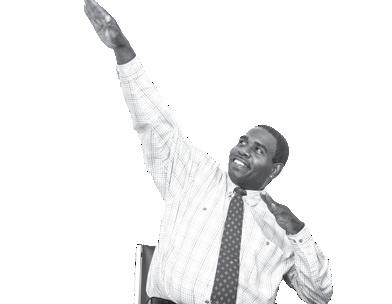
What is love? Is it, love means never having to say goodbye? Is it, love never remembering or holding on to the wrongs that has been transgressed against you? Or is it, love is not pompous and always self-seeking? Well, in retrospect, and penned in God’s holy book that “Love is patient, love is kind. It does not envy. It does not boast, it is not proud. It does not dishonor others, it is not self-seeking, it is not easily angered, it keeps no record of wrongs. Love does not delight in evil but rejoices with the truth. It always protects, always trusts, always hopes, always perseveres” — I Corinthians 13:4-7.
We must be ever so careful to remember the power of life and death is in our tongue.
I present to some, and introduce to others, “The original Reginald Denny.” Born to wonderful parents, Joseph and Amelia Denny, I am the eighth child of nine and the youngest of the five boys, having four beautiful sisters. My parents are originally from Bristol, Virginia, yet they moved here around the beginning of the 1960s. I was born on April 29 at the Columbia Hospital for Women. I do believe my parents were the most beautiful, influential people on God’s green earth. That’s my story, and I’m sticking to it. My mother and father were madly in love and would place anyone before the other. I could tell by the look in their eyes, and how they would embrace at those times when they shared that intimate kiss. It made me so happy they were happy! Joseph was a military man; he served in the United States Army. While enlisted in the service, he was awarded the “Purple Heart,” as well as the “Silver Star” for his active role while serving. Dad could even speak some German as a result of being in the military.
I was very proud to call him my daddy. From time to time, he would sit with me and tell stories and exploits of things he did and was faced with while enlisted in the army. My dad was well over six feet tall and a handsome young man with a lot of confidence exuding from him. The family called him “Big Joe Denny.” Amelia was a homemaker, domestic worker, and I thought she was the most beautiful woman in the world. When I became older, my mind was made up that I was going to find a girlfriend as beautiful as my mom. Mom worked for two prominent lawyers within the Chevy Chase quadrant of the District. She would rise up early in the morning, before it was time for me to go to school, and ask me to assist her in using the iron to press her somewhat damp slip and slightly wrinkled skirt-dress. She even introduced me to sewing and taught me how to use clear-fingernail polish in the temporary mending of her older stockings. My mother was a jewel, as well as intelligent. The greatest gift she passed on to me was her cooking and cleaning. I caught on quickly. What I liked best was preparing pound-cakes, pineapple upside-down cakes,
lemon cakes, coconut cakes and homemade biscuits. What she shared with me at a very young age prepared me and positioned me to fend for myself right today. I am exceedingly independent. As a result of my parents pouring into my life, even in the midst of some of our lacking, I still felt like I was rich, because of the love shown to me through them.
Joseph and Amelia are no longer here with us, they’ve gone on to be with the Lord but they left me with substance. They instilled in me the ability to not depend on other people but to be self-sufficient. I can remember some people getting and being jealous and envious and mad at me for having confidence even though I was supposedly poor. I had some good days and I had some bad days. I am assured and content at knowing that God is always with me no matter come what may. Love covers a multitude of sin. The things I’ve transgressed in throughout my life is what I did…thanks be to God thats not who I am. I have the favor of God upon my life regardless of what I’ve done. That’s the love! God has a plan for our lives and you can’t do a thing about it! God’s love for us will be brought to fruition if we but yield confess and receives the riches of his glory. That’s my story and I’m sticking to it.
You know, once upon a time, a long time ago in a neighborhood in D.C. there was once this young boy who enjoyed playing basketball, riding his bike and going swimming at the capital east pool which today is called “The Historical Eastern Market.” Life was so simple then at 11 and 12 years old. You got up in the morning washed up brushed your teeth, combed your hair and got your books together to ready yourself for school. Breakfast usually consisted of a bowl of cornflakes/ wheaties and milk and good ole piece of bread with butter and grape jam. The most important thing was to have something in our stomach off to school I would go!
Every now and then before going to school, as my mom was getting ready for work, she would have me iron her slip and shirt/dress while she got her hair or wig together. My momma used to wear coffee bean stockings. Sometimes she would have a run in her stockings. And she would use clearfinger-nail polish to help prevent them from getting a worse run. Momma would put on her lipstick and perfume and the fragrance smelled so good. Momma was so pretty when she got all her clothes just how she wanted. I’ll always love my momma, she’s my favorite girl!
My momma was my queen. Speaking now of fragrances, I can remember those orange cone-shaped flowers called “honeysuckles”. That’s love!
I’ve been thinking about the power of George Floyd. I realized that he was every man in so many ways, with many of the attributes of a Jesus paradigm. He worked, played, loved, fought, reached out to others — and what propelled his life, like so many of us in this turbulent society?
Soul music. Recently, my middle-of-the-wee-hours phone pal, Mr. Rope Flanagan of WPFW-FM, pulled up his DMV stakes and headed for, as it’s said, the flickering lights of Vegas. So, who now can flip a board switch every Saturday, 3:30 a.m., and draw back the virtual drapes of the “Lovers Lounge”? That deep, slow, efflorescence that can only spell “Amor,” the essence of human passion between the one who feels for another,despite the other person not always being too willing to bond back!
George Floyd’s loved ones, family, friends and his soulmate have all testified to the energizing “Quiet Storm”-style ballads in his life’s ethos. “Have I told you lately” by William Bell,“Love won’t let me wait ”by Major Harris, “You’re still a young man” by Bloodstone,“Fire and Desire” by Rick James and Teena Marie; all these and more suffused the drive of a mighty man just trying to make his way in a life where success and recognition are not guaranteed. Bookending Rope’s inventory of paeans to a beating heart on the front end, his show always began with Lee Williams and The Spiritual QC’s “All I have to do is wave my hand” and at 5 a.m. closing came the amazing “I’m gonna open up my heart” powerfully delivered by Marvin Junior and his broad palette of fellow vocalists in the Dells. This was the entry to Miss Millie Ware’s sunrise program of mellow moments. Feeling in flow with the aspirations of the late Mr. Floyd, my eyes never fail to brim over with joyous tears.
Love is not just a word, a saying, an action. It’s a belief, it’s a spell that can hurt you in many ways. But, it can also be a game changer in your life. Some people say love can blind you, which it can. But love is what you make it.
It’s a choice, a decision you make in your life. So I must warn you, choose wisely because just like life, love can be like a box of chocolates: You never know what you’re going to get.
Love can also be a feeling, a thought — love can even be a smell. The essence of love is all around us. It can be real or fake but there is a love that out beats every kind of love. That’s true love. Which is sacrifice, no excuse, no judgment, attachment. You know that love like your last name. You will fight, not give up, even when it hurts. Take the bad and the good. You're blinded to the flaws even when it’s wrong because it does not matter cause it’s true love. So remember — true love is basically respect for love. Remember my words: Respect is real love.
Lord bring me near the cross

While I am on the Christian journey It’s good to know you, Jesus And everybody should know the Lord He’s the Alpha and the Omega The beginning and the end One who sticks closer than a friend
It’s because of the blood that washes me clean as a flood Lord bring me near the cross In this present day So cloudy and gray It’s easy to lose your way Lord I wanna be tired Right with you With every step I take I just wanna be right With you Lord
Every day and every night In you, I put all my trust I don’t wanna be lost Lord bring me near the cross
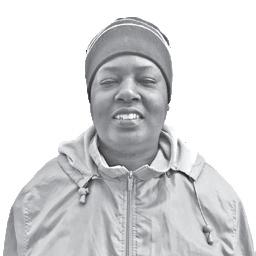
Some people say if you don't forgive someone, you will go to hell. But how many times must you forgive someone to avoid going to hell? God said to Peter, “I want you to forgive 70 times seven,” which is 490 times. Or, judgment will be made against you. To look at this from a new perspective, seven times is not enough times to forgive someone. We must love more. Love your enemies and pray for those who use you. It is about time to forgiven so you won’t become sickly. Forgive your mother, your father, your grandmother, your grandfather, your cousin, a stranger and other people.
 KYM PARKER Artist/Vendor
KYM PARKER Artist/Vendor
When I look up at the moon, I see beauty.
It is so majestic that I can see God; it is her way of showing us that everything will always be alright.
When I see the moon, I see hope, I see faith, and I see God.
When I look up to the moon, I see power; she helps us with gravity, gives us light, and shows us how to shine.
When I see how she makes everything bright, I see love and passion, I see the creation of God.
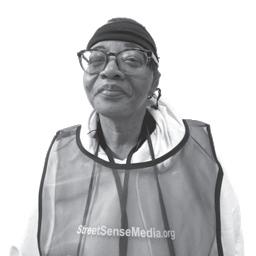
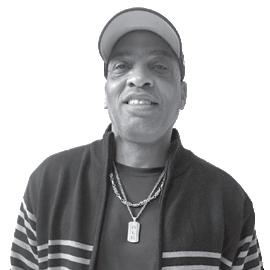


He’s been good to us
He woke us up this morning
He provided shelter
He provided food
He provided us with a family
He’s love
He’s the savior
I’m preparing for the prize of getting a healthier body temple. I took a look at myself and didn’t like my blood pressure. I was reading cholesterol results and decided to make a change become healthy. I search for free ways to exercise without spending a lot of money. I found walking up hills, skipping, dancing, marching, hula hooping and sprinting lessen the blows of low self-esteem and tiredness. My body resisted this at first. My body would speed up, shake and say loudly and clearly “I don’t want to!” I put a stop to those feelings and thoughts that were corrupting my
He kept us with a sane mind
He’s given us grace and mercy
He’s a friend in need
He’s always there He is worthy to be praised!
goal to be a better me, physically. I say with conviction that I can do this, I am lovely, and I feel great from the inside out. That relieves the pressure of giving up on myself.
You have to breathe in positive and exhale out all negative releasing all kinds of stress and obstacles that get in the way.
You can do this a little time every day and every other day or just a few days and it does work effectively on your body and you walk away feeling glorious and a little lighter. You can go to the grocery store and get some eggs, canned tuna, water-based vegetables and sweet fruit and lose five pounds a month.
Clearly, reaching goals in longevity is a better way to get
I was waiting for a train on the Green Line the other day and happened to be sitting next to a man who was attacked. Someone attempted to steal his phone.
The man who was attacked was just sitting on a bench with me with his headphones on, in his own world. A younger man in his thirties approached, pushing him saying, “What the F are you looking at? Gimme your MF phone!” The man jumped up and tried to get away, but not before his attacker landed two punches to his head.

It happened so fast that all I could do was jump up and get away from the altercation in hopes of maintaining my safety. The man did not give the attacker his phone and started to scream “Help! Help!” a few of us on the platform started to shout help too.
The Metro managers were slow to act, and even as we pointed at the attacker, they just let him walk out of the station. I suppose that might have been the safe thing to do, the police were called but ultimately the attacker got away and the victim filed a report.
This was a scary situation that triggered some PTSD flashbacks for me of some unsafe times. It makes me want to learn to protect myself better and to be aware of my surroundings. I no longer keep both of my headphones on and zone out when I am on the Metro. This situation could have turned fatal if that attacker had a weapon, or if no one has responded to our calls for help.
Be vigilant and proactive about your safety while you are out on the Metro.
COREY SANDERS Artist/VendorBeing happy is an emotion you really can’t control. When you’re happy, it flows through your soul. You can’t fake being happy, although people try sometimes. From the outside, you can see when a soul cries. Many of us have a lot going on and being happy sometimes isn’t a part of the song. But when it sets like that, just take a break and remind yourself that you are great. I guarantee after that thought, a smile will pop on your face.
healthier and learn for yourself instead of trying to store weights first and getting into other health issues. I realized that it made my body drop in blood pressure, cholesterol and in sugar used my body’s blood. Now I look at myself with a great big smile and enjoy what I see because the more energetic, slimmer and healthier person from the inside from the outside of my body head to toe feels fantastic for achieving this part of my continual life goal. Congratulations, me!
1. Always ride in a Metrorail car that has other people in it. Or in the first car where the operator of the train is located.
2. Be sure to set up a GPS locator on your mobile devices
3. Keep your small electronic devices and your phone in your pockets. If you must use your phone, hold it with both hands to make it more difficult to snatch.
4. If your phone or device is stolen, do not resist or chase the person. Take note of the clothing and identifying features of the attacker and call transit police (202-962-2121). You can also text 696873.
 DANIEL BALL Artist/Vendor
DANIEL BALL Artist/Vendor
I love all of you here at Street Sense Media. Why? Because you have never cheated me out of my money. And next, you have good classes five days a week. And when you have these classes, you can meet people and some good new vendors too.
How long have I been here at Street Sense? I’ve been here since 2008.
How many papers do I sell per week?
I said to Thomas and Will, “I can sell more papers than both of you can.”
So Thomas and Will said to me, “Man you are not for real, are you?”

I moved into my new place. It’s so beautiful, and I am so happy. I can take the elevator and go straight to my apartment. Thank you to my social workers and everyone who supported me. They all helped speed along the process. It’s a studio with a twoyear lease. Sleeping on the street is tough, and I am so glad I don’t have to do that anymore. I appreciate everyone who buys the Street Sense paper.

To all my vendors working for Street Sense — some of my customers told me some vendors are drinking while selling Street Sense. I told them a vendor should never drink while selling. So in the future, if you want to drink, take your vest off, put your papers away, get off your corner and go somewhere responsible, and have a drink. Customers may think we all drink while selling the paper. We all have to make each other look good, and be professional. We have to follow the code of conduct. You can’t drink while selling the paper. You know what I mean, we are not talking about soda or juice. Be smart.
In fact, some people have an income, but they don’t have the income to pay rent. Some have a steady income, like social security, but not all Social Security is enough to live off of or to find an affordable place to live in D.C. For example, I get $905 a month. A studio costs $700 to $1,500 per month. This is too much for me to afford unless I have a government voucher. That’s the only way for me to live in D.C. So, what I do is save some money — at least 50% of my check — in case I do get a voucher. That way, I’ll be ready to move in.
I was homeless for only four years. I was fortunate. So many D.C. residents were homeless before me. And many have remained homeless even after I received a housing voucher. My plight with homelessness, though not with poverty, ended around March 17, 2017, yet, there are still far too many who are not yet housed.



My first place after homelessness was in a particularly rough part of the Congress Heights neighborhood. I was assaulted in broad daylight by teenagers who knocked me down, causing my phone to become unusable. They said they were just having fun. Wasn't fun for me. Cost me $100 to replace my phone.
My dear friend, Alice Carter, was assaulted on at least two occasions. I begged her not to come to visit unless I was with her. Some damn young kid smacked her in the head with a baseball bat just because she failed to immediately hand over her purse as demanded.
The incident of my assault happened within 6 months of my living there and within just a few days, I was begging to
move. It took four years living in a scary neighborhood, but at last, in December 2021, I finally got my lifelong dream. I moved into a 10th-floor unit of a 10-story high rise in D.C.'s Waterfront neighborhood. I love everything so much about my new home, but the thing I love and enjoy most of all is the angular bay window in the living room. I find it kinda odd that my journey through homelessness is what it seems to have taken for me to get a million-dollar view from my bedroom, which I've placed in the living room rather than the bedroom of my one-bedroom unit. The view from the bedroom isn't bad, just not as grand as from the living room.
My wonderful window is about seven feet wide, including the 45-degree angled sections on each end and the flat section in the middle. From the middle of the window, I can see in the far distance the Wilson Bridge, as well as the confluence of the Anacostia and Potomac rivers. Off to the left, I can see the Frederick Douglas Bridge and Audi Field. On the right, I have a great view of the backside of the National Airport and can clearly see planes taking off and landing. Lots of helicopters,
Equipped only with his tools and his deadly aim, he has nothing to lose and everything to gain.
On his home, it says beware to the intruder, beware of the owner is a shooter,
Those unaware are shot on the spot, be it in a crowded mall or an empty parking lot.
He does what he does because it's all he knows, and in his line of work, anything goes.
It is the only way he knows to survive…
Shooting people in their everyday lives.
A quick flash of light much like an explosion is a true visual effect of a shooter unloading.
Did your ears deceive you? Better check your eyes because the owner shoots a camera to your surprise!

I saw a statistic that said the average length of stay in the shelter system dropped. This is a testament to the positive work that has been done to better match families with the services they need. We know much more about homeless families now and why they become homeless. While it’s still complicated, we know that families become homeless for different reasons, but that they can often be identified as families who are experiencing different kinds of poverty. Situational poverty is created by an event or temporary condition that impacts a family. For example, job loss, divorce or illness. These families for whom a brief stay in a shelter, along with the minimal services, are what they need to regroup and regain permanent housing.
too. Rolling puffy clouds and frequent flocks of birds are also part of the view from my bed through my wonderful window.
Fort McNair is immediately across the street, and it's comforting to hear the buglers play four times a day. I also enjoy hearing the crowds roar at soccer games.
I love everything about my new neighborhood and new apartment, but more than anything I love my wonderful window. The shades remain all the way up day and night. I really don't care if anyone can see inside. I insist that I always be able to see out.
I must offer sincere thanks to the Street Sense staff who helped me with some last-minute modest financial and genuine moral support that made my long-awaited move possible. I was supposed to have originally moved on Aug. 1, 2021, but due to dropped balls at the apartment leasing office, Pathways to Housing and DCHA, the move didn't actually take place until Dec. 16. But, a 4-and-a-half month delay was well worth finally getting my wonderful window.
All services listed are referral-free
Academy of Hope Public Charter School 202-269-6623 // 2315 18th Place NE aohdc.org
Bread for the City - 1525 7th St., NW // 202-265-2400
- 1700 Good Hope Rd., SE // 202-561-8587 breadforthecity.org
Calvary Women’s Services // 202-678-2341 1217 Good Hope Rd., SE calvaryservices.org
Catholic Charities // 202-772-4300 924 G St., NW catholiccharitiesdc.org/gethelp
Central Union Mission // 202-745-7118 65 Massachusetts Ave., NW missiondc.org
Charlie’s Place // 202-929-0100 1820 Connecticut Ave., NW charliesplacedc.org
Christ House // 202-328-1100 1717 Columbia Rd., NW christhouse.org
Church of the Pilgrims // 202-387-6612 2201 P St., NW food (1-1:30 on Sundays only) churchofthepilgrims.org/outreach
Community Family Life Services 202-347-0511 // 305 E St., NW cflsdc.org
Community of Hope // 202-540-9857 communityofhopedc.org
Covenant House Washington 202-610-9600 // 2001 Mississippi Ave., SE covenanthousedc.org
D.C. Coalition for the Homeless 202-347-8870 // 1234 Massachusetts Ave., NW dccfh.org
Father McKenna Center // 202-842-1112 19 Eye St., NW fathermckennacenter.org
Food and Friends // 202-269-2277 (home delivery for those suffering from HIV, cancer, etc) 219 Riggs Rd., NE foodandfriends.org
Friendship Place // 202-364-1419 4713 Wisconsin Ave., NW friendshipplace.org
Georgetown Ministry Center // 202-338-8301 1041 Wisconsin Ave., NW georgetownministrycenter.org
Loaves & Fishes // 202-232-0900 1525 Newton St., NW loavesandfishesdc.org
Martha’s Table // 202-328-6608 marthastable.org 2375 Elvans Road SE
2204 Martin Luther King Ave. SE
Miriam’s Kitchen // 202-452-8926 2401 Virginia Ave., NW miriamskitchen.org
My Sister’s Place // 202-529-5261 (24-hr hotline) mysistersplacedc.org
N Street Village // 202-939-2076 1333 N St., NW nstreetvillage.org
New York Avenue Shelter // 202-832-2359 1355-57 New York Ave., NE
Samaritan Inns // 202-667-8831 2523 14th St., NW samaritaninns.org
VIOLENCE HOTLINE
Línea directa de violencia doméstica 1-800-799-7233
Línea de salud
Bar Deco // 717 6th St NW
Samaritan Ministry 202-722-2280 // 1516 Hamilton St., NW 202-889-7702 // 1345 U St., SE samaritanministry.org
Sasha Bruce Youthwork // 202-675-9340 741 8th St., SE sashabruce.org
So Others Might Eat (SOME) // 202-797-8806 71 O St., NW some.org
Thrive DC // 202-737-9311 1525 Newton St., NW thrivedc.org
Unity Health Care 3020 14th St., NW // unityhealthcare.org - Healthcare for the Homeless Health Center: 202-508-0500 - Community Health Centers: 202-469-4699
1500 Galen Street SE, 1251-B Saratoga Ave NE, 1660 Columbia Road NW, 4414 Benning Road NE, 3946 Minnesota Avenue NE, 765 Kenilworth Terrace NE, 3240 Stanton Road SE, 3020 14th Street NW, 1717 Columbia Road NW, 1313 New York Avenue, NW BSMT Suite, 425 2nd Street NW, 4713 Wisconsin Avenue NW, 1333 N Street NW, 1355 New York Avenue NE, 828 Evarts Place NE, 810 5th Street NW, 850 Deleware Avenue SW, 65 Massachusetts Avenue NW, 4515 Edson Place NE
Washington Legal Clinic for the Homeless 1200 U St., NW // 202-328-5500 legalclinic.org
The Welcome Table // 202-347-2635 1317 G St., NW. epiphanydc.org/thewelcometable
Whitman-Walker Health 1525 14th St., NW // 202-745-7000 2301 MLK Jr. Ave., SE // 202-797-3567 whitman-walker.org
Last updated May 25, 2022
For further information and listings, visit our online service guide at StreetSenseMedia.org/service-guide
Part-time
Serve food to customers, keep workstations clean.
REQUIRED: N/A
APPLY: https://tinyurl.com/bardeco-bus
Target // 4500 Wisconsin Ave NW
Full-time/Part-time
Greet and assist customers, work in various stations throughout the store including the cashier, stocking shelves, and keeping the store clean.
REQUIRED: Lift up to 40 pounds.
APPLY: https://tinyurl.com/target-cashierstock
Nordstrom // 555 12th St NW
Full-time/Part-time
Assist customers at cashier and throughout the store, promote deals and rewards programs.
REQUIRED: N/A
APPLY: https://tinyurl.com/nordstrom-metro
Hiring?
@StreetSenseMedia.org


